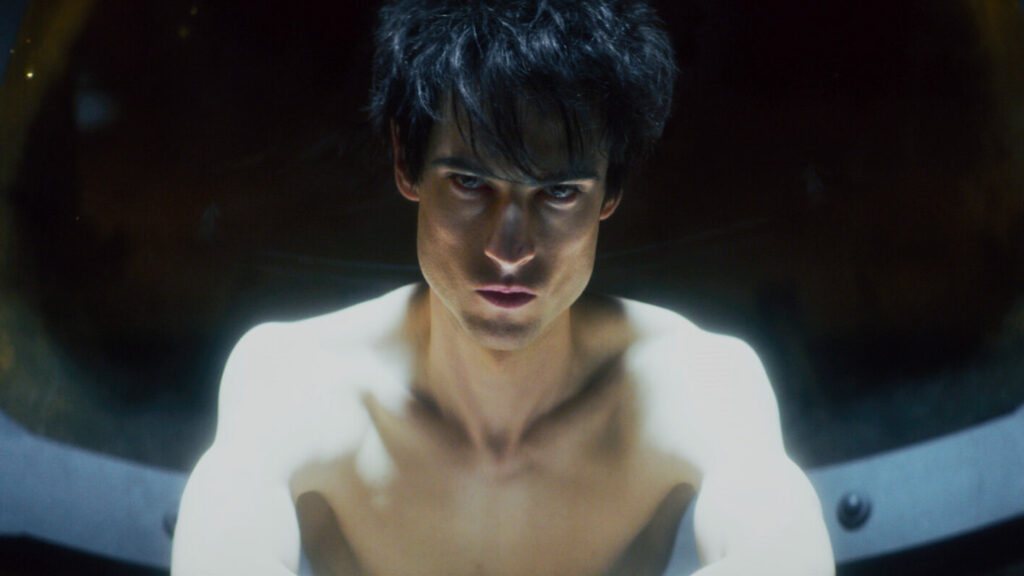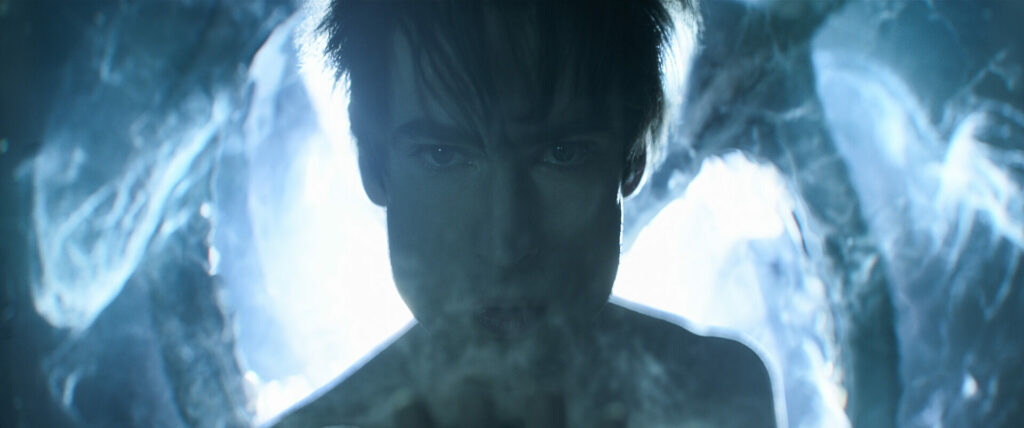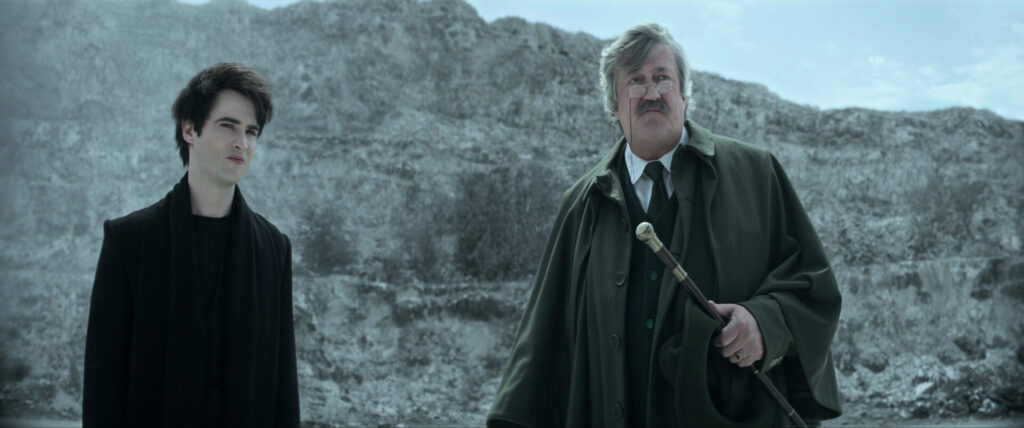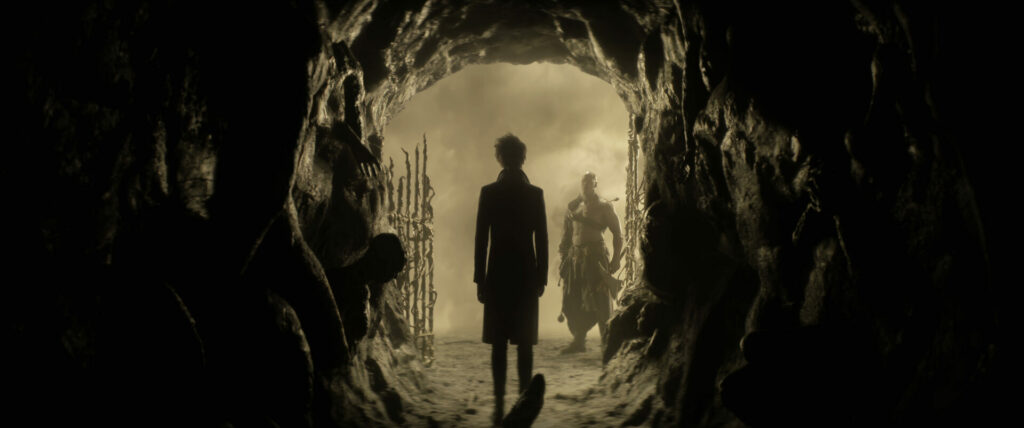Tom Sturridge on becoming Morpheus for Netflix’s ‘The Sandman’
When the first issue of Neil Gaiman’s ‘The Sandman’ hit the stands back in 1989, it changed the way people saw comic books forever. Now, it’s been adapted into a lavish Netflix series with British actor Tom Sturridge playing Morpheus, the titular Sandman

Tom Sturridge wears black, naturally. He may not be in character when we speak over video, but with his pale skin and dark hair, he does resemble Morpheus, the eponymous lead character he plays in Netflix’s eagerly anticipated new series The Sandman. The show has a strong goth element, much like the Neil Gaiman comic book series that it’s based off (one could identify the visual influence of musicians like Robert Smith and Siouxsie Sioux in Gaiman’s work), though Sturridge says he was never a part of that subculture in his youth. “Only because I respect that whole culture so much, I think it’s unfair to appropriate it,” he laughs. “But I think people who are part of my adolescence would definitely attribute many of the qualities required to me.”
Neil Gaiman’s original The Sandman comic ran for 75 issues between 1989 and 1996. Taking an old DC Comics superhero called ‘the Sandman’ as its basis, Gaiman reimagined the character as the godlike Morpheus, aka Dream, one of seven immortal siblings that make up ‘the Endless’ alongside Destiny, Death, Delirium, Destruction, Despair and Desire. Packed with literary references and using bold narrative techniques traditionally considered the preserve of prose literature, The Sandman escaped the comics ghetto and found a dedicated readership, particularly on college campuses around the world. Tori Amos even referenced Gaiman in a song, ‘Tear in Your Hand’; Gaiman repaid the compliment by basing the character Delirium on Amos. Today, the series is often discussed alongside Alan Moore’s Watchmen and Frank Miller’s The Dark Knight Returns as one of the benchmarks of the comic book medium.
Sturridge hadn’t read the original series before auditioning for the role, but he quickly became a fan. “The title was in my head before the audition, it’s pervasive in the culture,” he says. “The casting process was long — about eight months — so that gave me an opportunity to read all 3,000 pages over, and over again. And I genuinely fell in love with it. I think it’s one of the most important works of art from the last 30 years.”
Still, approaching how to actually play Morpheus was daunting. The character is, after all, as old as time itself whereas Sturridge is only in his thirties. Nevertheless, he was determined to capture the character’s sense of otherworldliness. “In the first sequence of the show, and the first frames of the comic, he’s silent and nude, trapped in a glass sphere,” Sturridge says. “What was important to me was conveying the sense that he was not human. There are very specific images of Morpheus naked in the comic, and what I take from them is that because he is metabolising dreams, he’s lost all his flesh. He’s just sinew and bone. I really wanted to make that body. I thought of him as a panther that’s been shaved. It’s not beautiful. I had no weight on me. Just strength. Because there was no other opportunity to say, ‘This is a member of the Endless.’ I wanted people to look at the body and think, ‘This is a creature’.”

While the comics presented a wealth of material for building Morpheus’s body language, by the very virtue of the medium, Sturridge had no direction when it came to how the character spoke. In the end, he went straight to the source to seek direction. “I very bluntly asked Neil [Gaiman], ‘What does he sound like?’” Sturridge says. “He explained two very important things to me. The first was that Morpheus has thought every thought that ever has been thought across the millennia of his existence, so when he speaks, it’s etched in stone. He’s not discovering an idea in the moment. It’s clarity personified.” No pressure there, then. “The second,” he continues, “is that he’s the voice inside your head. He must have authority. He must be potentially dangerous — but it has to be seductive enough for people to accept that invitation.”
“[Morpheus is] the voice inside your head. He must have authority. He must be potentially dangerous — but it has to be seductive enough for people to accept that invitation”
— Tom Sturridge
Born in London to actor Phoebe Nicholls and writer/director Charles Sturridge, performance is in Tom Sturridge’s blood. After appearing as a child actor in the 1990s, he began his career in earnest appearing in films like Being Julia, Like Minds and The Boat That Rocked throughout the 2010s, more recently appearing on-stage opposite Jake Gyllenhaal in the critically acclaimed 2019 play Sea Wall/A Life. Even so, taking the lead role of a major Netflix series and starring alongside the likes David Thewlis, Stephen Fry, and Charles Dance is a step up. It’s Sturridge’s chemistry with one co-star in particular — Gwendoline Christie, who plays the androgynous Lucifer, King of Hell — that stands out in The Sandman. “She’s one of the most intelligent human beings I’ve ever spent time with — as well as being one of the funniest,” says Sturridge. “She’s also incredibly seductive. She’s an extraordinary presence.”

“When we confronted each other, I discovered that Morpheus and Lucifer potentially have a deep underlying attraction to each other,” he adds. “That was helpful. There are very few equals in The Sandman. There’s always a hierarchy of office, or of literal power. But when Lucifer and Morpheus front up, it’s as equals. Lucifer being cast out of heaven isn’t so different from Morpheus being cast out of [his realm] the dreaming. They understand each other in a way many of the other characters don’t.”
The spiritual bent of the series, with pagan gods rubbing shoulders with Christian angels and demons, appealed to Sturridge. “The Sandman explores more traditional ideas of deity, it explores atheism, it explores finding faith in literature and in love. It explores death very deeply,” he says. “What I love about it is that it’s not prescriptive in its cosmology, and therefore I can find my own place inside it. I’m not being told what it is.”
“The Sandman explores more traditional ideas of deity, it explores atheism, it explores finding faith in literature and in love. It explores death very deeply”
— Tom Sturridge
Neil Gaiman is acknowledged as one of the all-time great comics creators, with his prose work in American Gods and The Graveyard Book winning him huge audiences and critical acclaim in the literary arena too. This love of literature was always clear in the Sandman series, where William Shakespeare appears as a character alongside Morpheus. Sturridge says that one of his favourite sequences in The Sandman “is when the fairies come over the hill and watch a performance of A Midsummer Night’s Dream. You have Puck watching himself being played. It’s a fascinating interrogation of that work.”
“What I didn’t expect was for The Sandman to be a story about stories,” Sturridge adds. “Because Morpheus is so prevalent in the iconography of it, you have this idea that he’s going to be this traditional protagonist or hero, whereas actually, he’s a guide. He leads us into a legion of stories.”

The Sandman introduced gay, trans, and genderfluid characters to comic book readers in the late eighties and early nineties. Yet when Netflix originally announced the casting for the series, there was a small but vocal minority of fans who kicked off a backlash against the casting of certain roles against the gender and ethnicities of the original characters. The situation left Sturridge perplexed. “It was so ahead of its time in its exploration of gender and sexuality and representation of women,” he says. “So the idea it wouldn’t be at the forefront of even further lucid descriptions of what the world is actually like when Neil [Gaiman] had the opportunity to adapt it again is utterly ridiculous.”
Not only are these changes in the spirit of the original text, they’re very much the wishes of Neil Gaiman. “People sometimes say, ‘Isn’t it amazing that Neil [Gaiman] gave you his blessing?’ He didn’t give his blessing — he was there every single day, whether in person or remotely, as a mentor and a guide.” He adds that The Sandman “was written a long time ago, and the world has changed immensely, so it’s important that these characters we know and love confront the reality of the world we live in now, and that births new stories and new avenues that are fascinating. We want people who love The Sandman to be surprised by this, as well. We’re devoted to the original, and this is an extraordinarily respectful adaptation, but at the same time, it isn’t a museum piece.”
The Sandman premieres on Netflix on 5 August 2022
